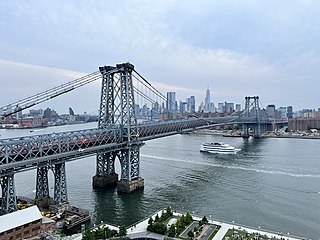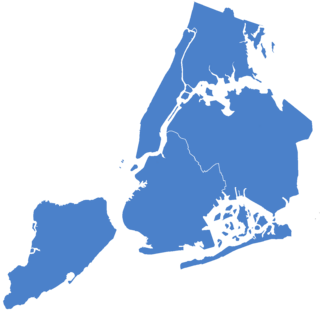
The Williamsburg Bridge is a suspension bridge across the East River in New York City, connecting the Lower East Side of Manhattan with the Williamsburg neighborhood of Brooklyn. Originally known as the East River Bridge, the Williamsburg Bridge was completed in 1903 and, at 7,308 feet (2,227 m) long, was the longest suspension bridge span in the world until 1924.

The Liberty Avenue station is a local station on the IND Fulton Street Line of the New York City Subway, located at the intersection of Liberty and Pennsylvania Avenues in East New York, Brooklyn. It is served by the C train at all times except nights, when the A train takes over service.

Peter Paul O'Dwyer was an Irish-born American politician and civil rights lawyer who served as President of the New York City Council during 1974–1977. He was the younger brother of Mayor William O'Dwyer, and the father of New York State Gaming Commission Chair Brian O'Dwyer.

Henry Cruse Murphy was an American lawyer, politician and historian. During his political career, he served as Mayor of Brooklyn, a member of the United States House of Representatives, U.S. Minister to the Netherlands, and member of the New York State Senate.

Irwin Steingut was an American lawyer, businessman and politician. At the time of his death he had served as a member of the New York Assembly longer than anyone in history. Early in his career he teamed with Brooklyn boss John H. McCooey, who turned Brooklyn into a solidly Democratic power base and dominated its politics for a quarter of a century until his death in 1934. Steingut thereafter became the de facto leader of the Brooklyn Democratic Party. Throughout almost all of his legislative career Republicans held a majority in the New York Assembly, and much of that time Steingut was the Minority Leader. In 1935 for the one year the Democrats had the majority, Steingut was Speaker of the Assembly.

The Riegelmann Boardwalk is a 2.7-mile-long (4.3 km) boardwalk on the southern shore of the Coney Island peninsula of Brooklyn in New York City, New York, United States. Opened in 1923, the boardwalk runs along the Atlantic Ocean between West 37th Street to the west, at the edge of the Sea Gate neighborhood, and Brighton 15th Street to the east, in Brighton Beach. It is operated by the New York City Department of Parks and Recreation.

Elections were held to elect the New York City Board of Aldermen on November 5, 1929, in concert with other such contests as the Mayor, the Comptroller, the President of the Board of Aldermen, Borough presidents, County Sheriffs, and other miscellaneous questions.
Martin F. Tanahey was an American politician who was the alderman of New York City's 1st district from 1922 to his death in 1930. A Democrat, he served much of the Lower East Side and Financial District in Manhattan.

Elections were held on November 2, 1937 to fill the New York City Council, which had just been formed to replace the New York City Board of Aldermen. The new Council comprised 26 members elected via proportional representation by borough, in contrast to the 65-member Board of Aldermen elected by district. This was done in response to the large majorities the Democrats often received in the Board of Aldermen. Each borough was entitled to one member of the council for each 75,000 votes cast, and an additional member for each remainder greater than 50,000. Due to voter turnout, Brooklyn was entitled to nine members of the Council, Manhattan six, Queens and The Bronx five each, and Richmond one.

Elections were held to fill the 65 seats of the New York City Board of Aldermen on November 5, 1935. They would be the final elections to the Board of Aldermen, which would be abolished in 1937 in favor of the New York City Council, which was elected via borough-wide proportional representation.

Elections were held on November 7, 1933, to fill the 65 seats of the New York City Board of Aldermen. Having been hitherto relegated to one seat held by Joseph Clarke of the 3rd district, Republicans were able to win 17 seats.

Elections of New York City's borough presidents were held on November 5, 1929, in concert with such contests as the mayoralty, Comptroller, aldermen, County Sheriffs, Aldermanic Board President, and other miscellaneous questions on the ballot. Democrats were elected in all Boroughs except Queens. This and Democratic victories in other contests were all a part of what was considered "a Crushing Defeat to [the] City G.O.P. [delivered]" by Tammany Hall.

An election was held on November 5, 1929, to elect the President of the New York City Board of Aldermen, in concert with other such contests as the mayoralty, Comptroller, the remainder of the Board of Aldermen, County Sheriffs, Borough presidents, and other miscellaneous questions on the ballot. Democratic incumbent Joseph V. McKee of The Bronx defeated Republican candidate Bird Sim Coler of Brooklyn, himself an independent Democrat, 890,655 votes to 385,514. This combined with Democratic victories in other contests formed what was considered "a Crushing Defeat to [the] City G.O.P. [delivered]" by Tammany Hall.

An election was held in New York City to election the President of its Council on November 2, 1897. The charter of the new City of Greater New York had created a bicameral Municipal Assembly, comprising an upper Council and a lower Board of Aldermen. The Council president was elected citywide while the Board of Aldermen elected its own president.

Elections were held to elect the borough presidents of New York City on November 5, 1901. Fusionists and Republicans won three of the city's five boroughs while Democrats were returned in The Bronx and Queens.

An election was held on November 7, 1933 to elect the President of the New York City Board of Aldermen, along with other contests such as the mayoralty, Comptroller, and aldermen. Democratic incumbent Joseph V. McKee had resigned earlier in the year to assume the office of Mayor after Jimmy Walker had resigned that position, and the aldermanic presidential post was occupied by Dennis J. Mahon in the meantime. Republican candidate Bernard S. Deutsch defeated Democratic candidate Milton Solomon and Recovery Party candidate Natan Straus Jr. to win the position.

An election for the New York City Comptroller was held on November 5, 1929, the same day as other such contests as the mayoralty, aldermen, President of the Board of Aldermen, Borough presidents, and County sheriffs. Incumbent Charles W. Berry was reelected, defeating Republican candidate Harold G. Aron, Socialist candidate Charles Solomon, and Square Deal Party candidate George E. Polhemus to win reelection. Communist Otto Hall, Social Laborite August Gillhaus, and Charlotte O. Schetter of the Commonwealth Land Party also contested the election.

An election was held to fill the Municipal Assembly of the newly created City of Greater New York on November 2, 1897. The charter of the new city had created a bicameral Municipal Assembly, consisting of an upper Council and a lower Board of Aldermen. Each chamber was elected from specially-made districts. In addition, the president of the Council was elected in a separate election on the same day.

The 1929 New York City mayoral election was held on November 5 in concert with other municipal elections. Democratic incumbent Jimmy Walker defeated Republican challenger Fiorello H. La Guardia in what was considered "a Crushing Defeat to [the] City G.O.P. [delivered]" by Tammany Hall. Socialist candidate Norman Thomas also ran, as did Socialist Labor candidate Olive M. Johnson and former Police Commissioner Richard Edward Enright for the Square Deal Party.
Augustus F. Pierce was an American politician who served as the Tammany Hall leader of the Bronx's 8th assembly district in New York City until his death in 1934. An employee of the city since 1907, at the time of his death he worked for the Department of Sanitation.














